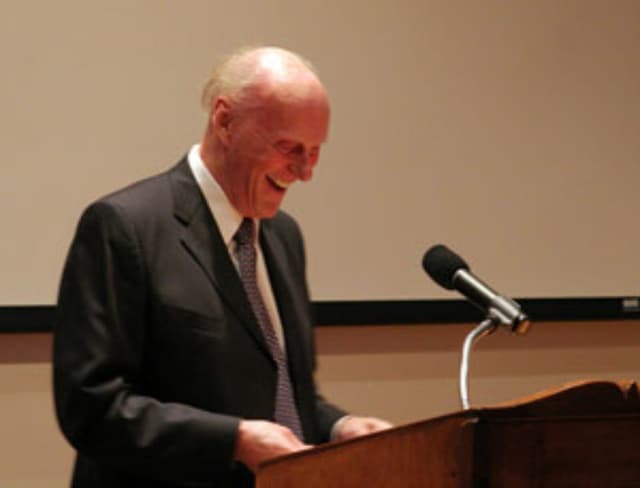For the Record: Remarks of Fred Kavli at Building Dedication for Kavli Institute for Particle Astrophysics and Cosmology, SLAC/Stanford University

Good afternoon. It is a special pleasure to be here today for the dedication of this beautiful building in the service of science.
First I want to remember and pay tribute to Leland Stanford and his wife, Jane, who laid the physical and spiritual foundation for this great university, and who in their foresight provided the ample land on which this building stands today.

Fred Kavli addressing audience at Stanford dedication.
We owe our gratitude to the many people who have been instrumental in making the Kavli Institute for Particle Astrophysics and Cosmology and the building come about, and give special recognition to President Hennessy, Provost Etchemendy, and the Department of Energy, represented by Robin Staffin. We appreciate the capable work of Roger Blandford, Jonathan Dorfan, and Steven Kahn, who are the prime engines in this effort, and we recognize Steven Chu for his contribution in starting the Institute.
We truly have a great building on a wonderful site, and I want to recognize the architectural firm of EHHD for a beautiful and functional design.
The building will be an important focal point for the activity of the Kavli Institute for Particle Astrophysics and Cosmology. It is especially important since the Institute is a joint effort of Stanford and SLAC, and the new building will help to integrate the scientific effort of the two institutions, and will be a common meeting ground for participants from each as well as for visitors from many other institutions.
The prominent location is symbolic of the central role it will play in this function.
But the building cannot fulfill its function without content, and we are especially thankful to Pierre Schwob who donated the computer center, and Pehong Chen who donated the Chair for the director of the Kavli Institute.
The Kavli Foundation supports basic science because we believe in its long-range benefit to humanity. We are looking for benefits which may lie far into the future, benefits that may be hard to predict, but as we look at the past, the benefits of science have been proven over time. The fruits of research are not always immediate and are often not predictable. Often the benefits are the result of unpredictable outcomes of an exploration that was initially motivated purely by intellectual curiosity.
Heisenberg, Schrodinger, and Dirac were not motivated by practical applications when they and their colleagues developed the quantum theory of matter, and yet, their research led to, among other results, an understanding of electronic conduction in solid state materials, which led to the invention of the transistor, which made possible the development of integrated circuits, computers, the internet, and the IT world in which we live today.
I believe there is a strong relationship between the level of a nation’s science and its technological and industrial leadership in today’s high-tech world.
For many years, Bell Laboratories was the strongest and best scientific research institution in the world. The research from Bell Labs was freely publicized throughout the world, but who was to take primary advantage of it to build a high technology industry? It was the home country, the United States of America. It is not just a matter of knowing the theory, it is the foundation that is built step by step by scientists, the engineers, the technicians, the suppliers, the scientific infrastructure, and it is the whole underlying knowledge base that transfers pure science into industrial benefits. I believe that without the Bell Labs, the U.S. would not be the strong world leader we are today in high technology.
Similarly, the Silicon Valley would not be among the very top world technological centers without Stanford and SLAC.
It is well known and widely accepted that investments in research yield enormous benefits to society through improved standard of living, better health, and stronger national security.
I believe that basic science is the primary driver for human progress and increased knowledge about the human being, nature, and the universe.
It is for these reasons that we must be willing to make investments with a long horizon, and it is important that our leaders in government duly recognize the importance of our scientific standing in providing a superior standard of living. Sacrifices that we make today will build our future of tomorrow.
The benefits of basic science can be hard to predict, but based upon the past, the future will be more spectacular than we can ever imagine.
And to the scientists I want to say, I envy you out there looking back to the beginning of time, playing among the galaxies. You guys are really good packing 100 billion galaxies with hundred billion stars each in the space of a subatomic particle, but when you tell me there are 11 dimensions, I like to remind you of Paul Dirac’s statement that said “physical laws should have mathematical beauty and simplicity.”
Today we are grateful to have this beautiful facility with an outstanding team of scientists backed up by two great institutions. I am confident that you will make new discoveries and advance our understanding of the cosmos.
Let us dedicate this house of science to take us on a ride among the stars to answer some of our most fundamental questions.